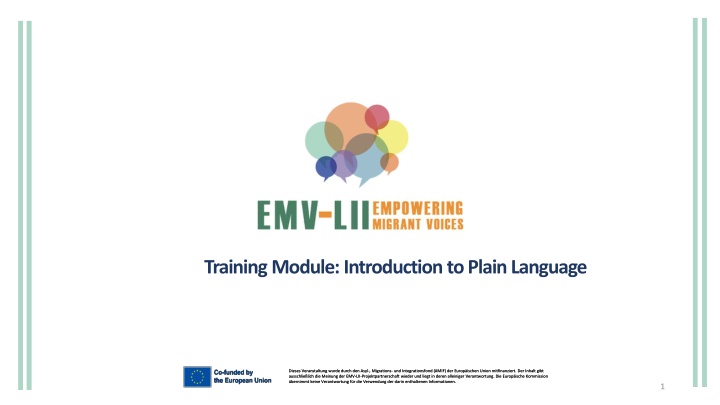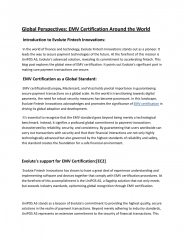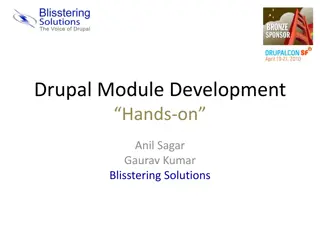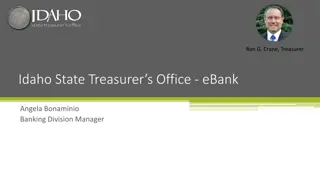
Introduction to Plain Language Training Module
"Learn about plain language communication funded by the European Union AMIF and developed by EMV-LII Projektpartnerschaft. Understand plain language concepts, tools, and objectives. Explore agenda topics and examples of simple language use."
Download Presentation

Please find below an Image/Link to download the presentation.
The content on the website is provided AS IS for your information and personal use only. It may not be sold, licensed, or shared on other websites without obtaining consent from the author. If you encounter any issues during the download, it is possible that the publisher has removed the file from their server.
You are allowed to download the files provided on this website for personal or commercial use, subject to the condition that they are used lawfully. All files are the property of their respective owners.
The content on the website is provided AS IS for your information and personal use only. It may not be sold, licensed, or shared on other websites without obtaining consent from the author.
E N D
Presentation Transcript
Training Module: IntroductiontoPlainLanguage Dieses Veranstaltung wurde durch den Asyl-, Migrations- und Integrationsfond (AMIF) der Europ ischen Union mitfinanziert. Der Inhalt gibt ausschlie lich die Meinung der EMV-LII-Projektpartnerschaft wieder und liegt in deren alleiniger Verantwortung. Die Europ ische Kommission bernimmt keine Verantwortung f r die Verwendung der darin enthaltenen Informationen. bernimmt keine Verantwortung f r die Verwendung der darin enthaltenen Informationen. Dieses Veranstaltung wurde durch den Asyl-, Migrations- und Integrationsfond (AMIF) der Europ ischen Union mitfinanziert. Der Inhalt gibt ausschlie lich die Meinung der EMV-LII-Projektpartnerschaft wieder und liegt in deren alleiniger Verantwortung. Die Europ ische Kommission 1
Training Objectives Training Objectives Understanding the concept of plain language Be able to use simple language Knowledge of important tools and work aids Dieses Veranstaltung wurde durch den Asyl-, Migrations- und Integrationsfond (AMIF) der Europ ischen Union mitfinanziert. Der Inhalt gibt ausschlie lich die Meinung der EMV-LII-Projektpartnerschaft wieder und liegt in deren alleiniger Verantwortung. Die Europ ische Kommission bernimmt keine Verantwortung f r die Verwendung der darin enthaltenen Informationen. 2
Agenda Agenda 1. Definition and Characteristics of Plain Language 2. How to Use Plain Language 3. Check-Lists and Recommendations 3
1. Definition and Characteristics of Plain Language 4
Introduction and Definition of Plain Language Introduction and Definition of Plain Language Definition by the International Plain Language Federation: A communication is in plain language if its wording, structure, and design are so clear that the intended readers can easily find what they need, understand what they find, and use that information For people with limited reading and writing skills, non native speakers, broad audience Source: https://www.iplfederation.org/plain-language/ 5
Example of Simple Language Example of Simple Language The application must be completed by the applicant and received by the financial office by June 1st. We must receive your application by June 1st. Source: https://www.plainlanguage.gov/examples/before-and-after/application-due-date/ 6
Relevance and Benefits of Plain Language Relevance and Benefits of Plain Language Advantages of plain language: Improved communication Better understanding Better access to information Easier to translate into other languages Makes information available for more target groups Sources: https://deptofcivicthings.com/what-is-plain-language-and-why-you-need-to-use-it/ & https://centerforplainlanguage.org/learning-training/five-steps-plain-language/ 7
Characteristics of Plain Language Characteristics of Plain Language Well-structured text: logically organised; divided into small paragraphs; with subheadings and highlighting; Short sentences with a simple structure: up to 15 words per sentence (rarely up to 20 words); no more than one subordinate clause Simple word forms: strong verbs (instead of noun + weak verb); if possible active instead of passive; rarely subjunctive; Comprehensible words: basic vocabulary; if possible, no abbreviations, no technical terms or foreign words (explain if necessary); Short words: avoid long words; Easy-to-read font: sans serif letters, larger than usual font, large line spacing; Clear pictures: Photos and drawings that match the text. Sources: https://portaleinfach.org/abc-der-einfachen-sprache/ 8
Exercise/ Discussion Exercise/ Discussion 1 + plenary 10-20 min. Thinking about possible applications of plain language in your organisation Description of the method: 1. Reflect on how plain language works in professional contexts and where it is particularly important. 2. If doing this exercise in a group: Discuss your reflection with the group. 9
Content Planning Content Planning Before you start, ask yourself: Who will be reading the text? What is the purpose of your text? What points should the text cover? (Decide on your message and cross out irrelevant points) Organise information logically 11
Wording and sentence structure Wording and sentence structure Use simple, familiar words Use concise, simple sentences: short sentences are easier to read Present important information first Leave out details that don t help or may distract readers Use active voice Address your reader with you Examples and analogies can clarify complex concepts Sources: https://deptofcivicthings.com/what-is-plain-language-and-why-you-need-to-use-it/ & https://centerforplainlanguage.org/learning-training/five-steps-plain-language/ 12
Wording and sentence Wording and sentence structure: Example of Plain Language structure: Example of Plain Language The following documentation must be provided at the time of appointment to satisfy eligibility requirements. You must show the following documentation at your appointment to prove you are eligible. Source: https://deptofcivicthings.com/what-is-plain-language-and-why-you-need-to-use-it/ 13
Visual Visual Clarity Clarity and and Formatting Formatting Organise information in manageable chunks. Start with the most important message Use headings, paragraphs and lists to help people scan the text. Create visual hierarchy through font size and format (bold words for important terms, avoid fonts that are too small). Highlight important concepts. Source: https://www.plainlanguage.gov/guidelines/organize/add-useful-headings/ & https://deptofcivicthings.com/what-is-plain-language-and-why-you-need-to-use-it/ 14
Example: Clarity over Brevity Example: Clarity over Brevity 254.12 Applications 254.12 How do I apply for a grant under this part? Source: https://www.plainlanguage.gov/guidelines/organize/add-useful-headings/ 15
Correct and Correct and Precise Wording Precise Wording The use of precise words is important for the comprehension of the readers Common pitfalls: Avoid jargon and acronyms (for example: involuntarily undomiciled vs. homeless) Avoid hidden verbs (a verb turned into a noun) Example for hidden verbs: We will announce We will make an announcement Source: https://deptofcivicthings.com/what-is-plain-language-and-why-you-need-to-use-it/ 16
Repeating and Repeating and Emphasizing Emphasizing I Important Points mportant Points Use the same terms for the same concept/ object (don t use synonyms). Emphasize key messages through repetition in clear and simple language. Sources: https://deptofcivicthings.com/what-is-plain-language-and-why-you-need-to-use-it/ 17
3. Check-Lists and Recommendations 18
Checklist for Checklist for Plain Language Plain Language written for the average reader organized to serve the reader s needs has useful headings uses you and other pronouns to speak to the reader uses active voice uses short sections and short sentences uses the simplest tense possible simple present is best uses base verbs, not hidden verbs omits excess words uses concrete, familiar words uses must to express requirements; avoids the ambiguous word shall places words carefully (avoids large gaps between the subject, the verb and the object; puts exceptions last; places modifiers correctly) uses lists and tables to simplify complex material uses no more than two or three subordinate levels Source: https://www.plainlanguage.gov/resources/checklists/checklist/ 19
Recommendations for Recommendations for Practical Use Practical Use Recommendations: Common words Exact and concrete words Short wordsAvoid filler words Avoid abbreviations Short sentences: Verbal style Active form Maximum of two subordinate clauses Avoid superfluous information Support tools: Hemingway Editor: https://hemingwayapp.com/ AI tool to make texts more concise and easier to understand 20





















